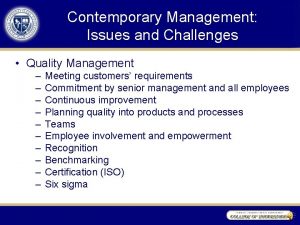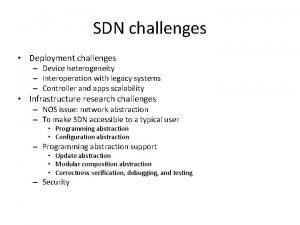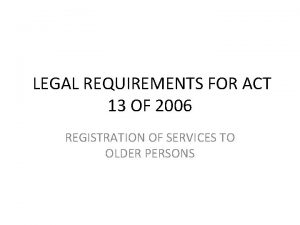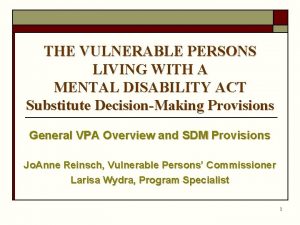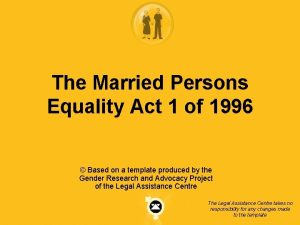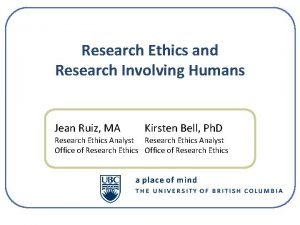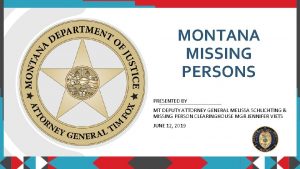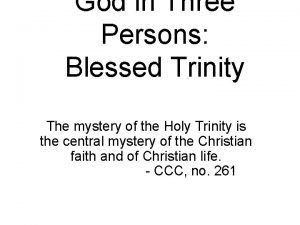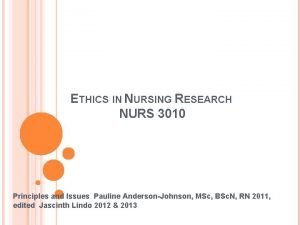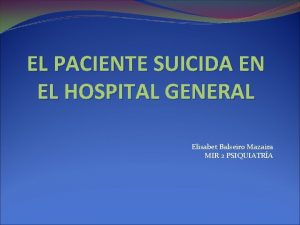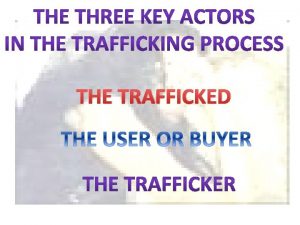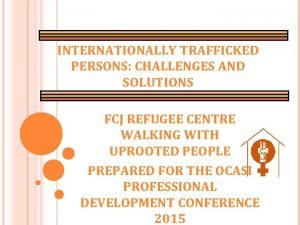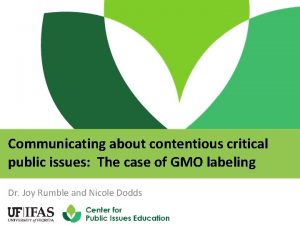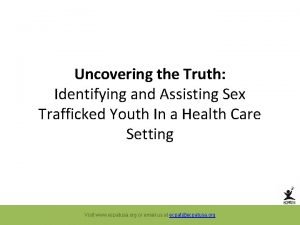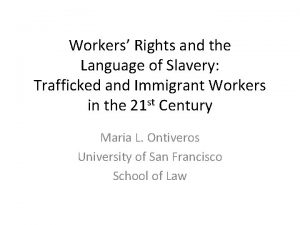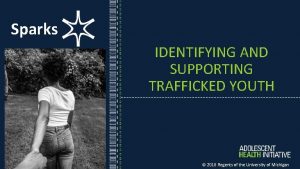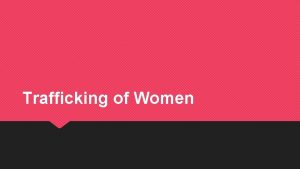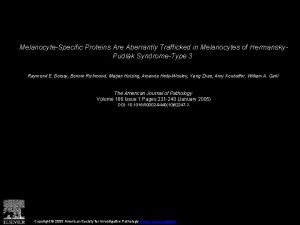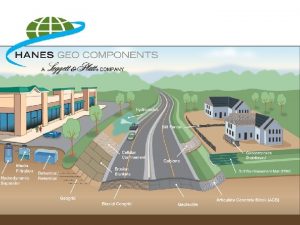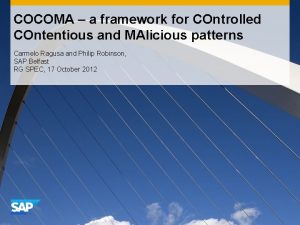Assistance to trafficked persons Challenges and contentious issues

















- Slides: 17

Assistance to trafficked persons: Challenges and contentious issues Glasgow, Scotland 13 December 2012 Blanka Hancilova, Ph. D Independent Researcher and Consultant ARC Network Advice*Research*Capacity Results Based Management, Gender, Labour, Migration This presentation was developed in close cooperation with Daja Wenke, Independent Researcher and Consultant on Child Rights and Child Protection

What are we talking about? (1) The act: ‘recruitment, transportation, transfer, harbouring or receipt of persons’ (2) Committed by means of: ‘the threat or use of force or other forms of coercion, of abduction, of fraud, of deception, of the abuse of power or of a position of vulnerability or of the giving or receiving of payments or benefits to achieve the consent of a person having control over another person’ (3) For the purpose of ‘exploitation’.

The act ‘recruitment, transportation, transfer, harbouring or receipt of persons’ Element of action ‘movement’ – not required by international law, but discussion is ongoing

The means ‘the threat or use of force or other forms of coercion, of abduction, of fraud, of deception, of the abuse of power or of a position of vulnerability or of the giving or receiving of payments or benefits to achieve the consent of a person having control over another person’ Element of ‘use of force’ (means) is still considered a central aspect

Exploitation – the purpose Exploitation includes “at a minimum, the exploitation of the prostitution of others or other forms of sexual exploitation, forced labour or services, slavery or practices similar to slavery, servitude or the removal or organs”. Element of ‘exploitation’ is not sufficiently defined

Applying the concept of exploitation Response to trafficking cases is prioritised over general response to exploitation and persons who are exposed to exploitation but not considered trafficked may remain unprotected Difficult to understand exploitation when there is no physical violence, restriction involved (loverboys? ) Exploitation is not defined (forced begging, forced crime, consensual exploitation) No guidance on how to identify exploitation Some forms of exploitation can be prosecuted only when they constitute trafficking

Difficulties in practical application of the legal concepts Limited scope of the forms of exploitation Continuum of exploitation (from decent work to worst forms of exploitation and forced labour) Inconsistencies within the national laws Difficult to apply the ‘irrelevance of consent’ in practice Challenge of identifying trafficking cases in absence of physical force or violence Different interpretations by service providers and law enforcement

The Actors (Trafficked) persons Judiciary Specialized services for trafficked persons (incl. legal, psychological, health, incl. reproductive health) Prosecution Social services Police, Immigration authorities

Key elements of improved response Maximum realisation of potential through mutual trust, cooperation and common commitment Individual perspective and strengths of each actor Cooperation should be guided by a human rights-based approach: The victim at the centre

The perception of a ‘victim’ Stereotype perceptions of a ‘victim’ strongly guide the identification and related proceedings: Experience of extreme violence Behaviour Agency National and ethnic origin Gender Age Important to overcome stereotypes Understanding ‘victim of crime’ as a legal concept Standards and guidelines by the UN, Council of Europe, EU put in place broader responses for all victims of crime

Support and assistance Strongly built on ‘categorisation’ of persons Individuals need to ‘fit’ into existing systems: trafficked persons, asylum seekers, persons qualified for social assistance (EU citizens) Many unresolved questions in offering support and assistance Challenge of building trust Close cooperation between law enforcement and social services Access to independent information Access to quality legal advice (immigration issues, compensation) Need to define how to work with closed institutions

Good practices Cross-sectoral cooperation in best interests assessments Consolidate existing tools for maximum quality standards Holistic approach

Cross-sectoral cooperation Cooperation between law enforcemen t and social services is critical for addressing trafficking: • Identification • Investigation • Building trust • Safeguarding the trafficked person rights in legal and administrative proceedings • Security

Cross-sectoral cooperation 2 Institutionalise cross-sectoral cooperation mechanisms at the local level (good example - Italy? ) Involve other sectors: immigration authorities, health professionals, private sector, educational institutions. Recognise strengths and limitations of each sector

Towards a victim-centered, rightsbased approach The focus on identification of the status of a victim of trafficking seems to override the broader rights-based assessments Other infringements against the rights are not necessarily considered

Implementation in practice The national laws, structures and systems are not perfect but offer a wide range of action Ensure that national laws are effectively applied and implemented Need for more preventive action: national / regional Challenge existing systems: Innovation through structural change combined with mindset change Rights-based and investment approach for social cohesion, development and nation building

Thank you! Blanka Hancilova hancilova@arc-network. org
 Thomas putnam
Thomas putnam One persons trash is another persons treasure
One persons trash is another persons treasure The crucible act 1 vocabulary
The crucible act 1 vocabulary Vocabulary workshop unit 10 level e
Vocabulary workshop unit 10 level e What are contemporary management issues
What are contemporary management issues Big data: issues, challenges, tools and good practices
Big data: issues, challenges, tools and good practices Sdn issues and challenges
Sdn issues and challenges Older persons act norms and standards
Older persons act norms and standards Willow cabin speech
Willow cabin speech Liable to vat
Liable to vat The vulnerable persons living with a mental disability act
The vulnerable persons living with a mental disability act Married persons equality act 1 of 1996
Married persons equality act 1 of 1996 The principle of respect for persons
The principle of respect for persons Missing person montana
Missing person montana Church fathers trinity
Church fathers trinity The principle of respect for persons
The principle of respect for persons The principle of respect for persons
The principle of respect for persons Escala de sad persons
Escala de sad persons




